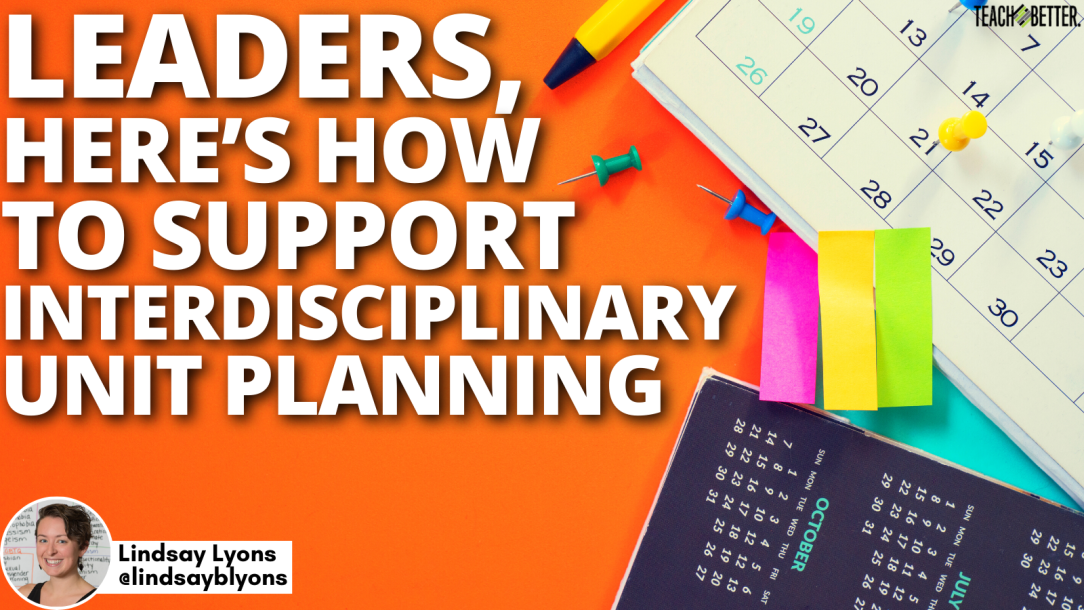TL;DR:
- Interdisciplinary units deepen students’ learning experiences.
- Have teachers decide what they want to focus on for an interdisciplinary unit.
- Hold a planning meeting to talk about the unit and co-plan.
- Plan on meeting throughout the unit with other teachers to see how it’s going and tweak things.
- Allow teachers to teach what they’re excited about.
- Celebrate your successes!
Interdisciplinary Units
Interdisciplinary units are a fantastic way to develop students’ analytical, creative, and problem-solving skills. Research has found interdisciplinary units deepen and broaden students’ learning. These units also facilitate faster information retrieval for students and improve students’ attitudes toward learning! It’s great for teachers too! Interdisciplinary unit planning facilitates a culture of professional collaboration among teachers, which, along with the result of high student engagement and achievement, decreases teacher burnout.
So, how can we set teachers up for successful interdisciplinary planning?
Research has found interdisciplinary units deepen and broaden students’ learning. These units also facilitate faster information retrieval for students and improve students’ attitudes toward learning! Click To Tweet
Getting Started with an Interdisciplinary Unit
- Ask which teachers are interested in developing an interdisciplinary unit.
- Invite each teacher to list their priority standards and/or content focus for the year. Then, ask each teacher to put it on the calendar. When would they plan to teach each standard and/or content?
- Once the maps are outlined, teachers can identify areas of overlap and pick a focus topic. Tip: Science or Social Studies topics often work best as ELA and Math skills are able to be applied to a variety of specific contexts.
- Next, coach the teachers to come up with a compelling driving question to frame the unit.
The Planning Meeting
Once teachers have the topic and question, invite them to meet and complete the following items:
- Decide the degree of collaboration. Is each teacher teaching a totally separate unit under the umbrella of the shared topic and question? Is each lesson going to be co-planned? Will it be something in between? Perhaps each teacher takes a few skills and subtopics to teach and they plan independently.
- Identify supporting questions. Consider what subject-specific questions students would need to be able to answer in order to tackle the overarching driving question.
- Pick a core text (if relevant to the chosen degree of collaboration).
- Revise their pacing calendars to align with their decisions, including when assessments will occur. (Tip: Teachers can co-create one summative assessment for both classes, with each teacher giving feedback and grades on the standards that are aligned with their class.)
- Design a hook lesson(s) to begin the unit.
Continued Collaboration
After the initial planning meeting, each teacher can plan out the lessons for their class. Encourage teachers to schedule a time to meet to check for lesson alignment and coherence. Alternatively, teachers could communicate via comments in a shared document.
[scroll down to keep reading]Leader Tips
An interdisciplinary curriculum can feel like a major undertaking. How you might be able to generate and sustain excitement and reduce the possibility of overwhelm or frustrated? Here are some ideas:
- Keep it fun! Get teachers excited by sharing a cool interdisciplinary project you saw or heard about.
- Start small. When teachers plan separate units around a shared theme, they start to see possibilities for student engagement.
- Offer support. Facilitate PD workshops or connect teachers with PD on how to do this well. Create shared common planning time for grade teams. Pay teachers for any extra work hours that go into interdisciplinary curriculum development.
- Don’t force it. If teachers are not interested, don’t push them to write an interdisciplinary unit. Instead, offer to cover a class for that teacher so they can go see an interdisciplinary lesson in action. Let teachers see what’s possible and get excited on their own. Then, support them when they’re ready. In the same vein, don’t force superficial connections.
- Celebrate success! Show off student work at the end of an interdisciplinary unit by hosting a student showcase, project fair, or publishing party. Invite teachers who are doing this work to host guests from other grades or schools in their classrooms and find opportunities for them to visit other classrooms where they can see interdisciplinary units in action.
Co-Planning an Interdisciplinary Unit
Co-planning an interdisciplinary curriculum yields tons of energy and creativity. Joshua Aromin said creating interdisciplinary units offers teachers “the chance to be such a better teacher by getting to stretch your own brain outside of the box of your own subject area, and getting to learn more about another subject area.”
The approach and tips in this post come from a bonus module within Curriculum Boot Camp, a self-paced online course that helps teachers create units that challenge, affirm, and inspire all students.
About Lindsay Lyons
Lindsay Lyons is an educational consultant who works with teachers and school leaders to inspire educational innovation for racial and gender justice, design curricula grounded in student voice, and build capacity for shared leadership. Lindsay taught in NYC public schools, holds a PhD in Leadership and Change, and is the founder of the educational blog and podcast, Time for Teachership.




